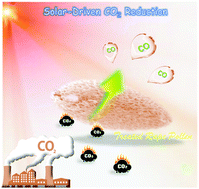当前位置:
X-MOL 学术
›
Energy Environ. Sci.
›
论文详情
Our official English website, www.x-mol.net, welcomes your feedback! (Note: you will need to create a separate account there.)
Nature-based catalyst for visible-light-driven photocatalytic CO2 reduction†
Energy & Environmental Science ( IF 32.5 ) Pub Date : 2018-06-27 00:00:00 , DOI: 10.1039/c8ee01781f Zhifeng Jiang 1, 2, 3, 4, 5 , Hongli Sun 4, 5, 6, 7 , Tianqi Wang 4, 5, 6, 7 , Bo Wang 4, 5, 6, 7 , Wei Wei 1, 2, 3, 4 , Huaming Li 1, 2, 3, 4 , Shouqi Yuan 1, 2, 3, 4 , Taicheng An 4, 8, 9, 10, 11 , Huijun Zhao 12, 13, 14, 15 , Jiaguo Yu 4, 16, 17, 18 , Po Keung Wong 4, 5, 6, 7
Energy & Environmental Science ( IF 32.5 ) Pub Date : 2018-06-27 00:00:00 , DOI: 10.1039/c8ee01781f Zhifeng Jiang 1, 2, 3, 4, 5 , Hongli Sun 4, 5, 6, 7 , Tianqi Wang 4, 5, 6, 7 , Bo Wang 4, 5, 6, 7 , Wei Wei 1, 2, 3, 4 , Huaming Li 1, 2, 3, 4 , Shouqi Yuan 1, 2, 3, 4 , Taicheng An 4, 8, 9, 10, 11 , Huijun Zhao 12, 13, 14, 15 , Jiaguo Yu 4, 16, 17, 18 , Po Keung Wong 4, 5, 6, 7
Affiliation

|
We demonstrate a rational fabrication of hierarchical treated rape pollen (TRP), a biological material used as a metal-free catalyst for visible-light-driven photocatalytic CO2 reduction. The TRP catalyst exhibits excellent visible-light-driven carbon monoxide (CO) formation of 488.4 μmol h−1 g−1 with 98.3% selectivity, using no co-catalyst or sacrifice reagent, accompanied by a high quantum efficiency of over 6.7% at 420 nm. The CO evolution rate obtained on the TRP catalyst is roughly 29.4 and 25.6 times higher than those of the most commonly reported photocatalysts, such as g-C3N4 (16.6 μmol h−1 g−1) and P25 TiO2 (19.1 μmol h−1 g−1), and is the highest among the reported carbon-based photocatalysts. In situ Fourier transform infrared spectrometry analysis disclosed that formic acid is a major intermediate. The considerable photocatalytic CO2 reduction activity observed on the TRP catalyst can be ascribed to the following factors: (i) the unique hollow porous structure of the TRP favours visible light harvesting and CO2 adsorption capacity; and (ii) the interior cavity of the TRP can decrease the diffusion length of the photogenerated reactive charge carrier from bulk to surface, thus promoting charge carrier separation. We anticipate that such a nature-based sustainable photocatalyst can provide new insights to facilitate the design of metal-free catalysts with outstanding visible-light-driven CO2 reduction performance.
中文翻译:

用于还原可见光的光催化CO 2还原的天然催化剂†
我们证明了合理处理的分层处理的油菜花粉(TRP),一种用作无金属催化剂的生物材料,用于可见光驱动的光催化CO 2还原。TRP催化剂在不使用助催化剂或牺牲试剂的情况下,具有488.4μmolh -1 g -1的可见光驱动的一氧化碳(CO)形成,选择性为98.3%,在90 ℃时具有超过6.7%的高量子效率,具有出色的可见性。 420纳米 在TRP催化剂上获得的CO释放速率比最常报告的光催化剂(例如gC 3 N 4(16.6μmolh -1 g -1)和P25 TiO 2(19.1μmolh )高约29.4和25.6倍-1 g -1),在报道的碳基光催化剂中最高。原位傅里叶变换红外光谱分析表明,甲酸是主要中间体。在TRP催化剂上观察到的可观的光催化CO 2还原活性可归因于以下因素:(i)TRP独特的中空多孔结构有利于可见光收集和CO 2吸附能力 (ii)TRP的内腔可以减小光生反应性电荷载体从本体到表面的扩散长度,从而促进了电荷载体的分离。我们预计,这种基于自然界的可持续光催化剂可以提供新见解,以促进具有出色的可见光驱动的CO 2还原性能的无金属催化剂的设计。
更新日期:2018-06-27
中文翻译:

用于还原可见光的光催化CO 2还原的天然催化剂†
我们证明了合理处理的分层处理的油菜花粉(TRP),一种用作无金属催化剂的生物材料,用于可见光驱动的光催化CO 2还原。TRP催化剂在不使用助催化剂或牺牲试剂的情况下,具有488.4μmolh -1 g -1的可见光驱动的一氧化碳(CO)形成,选择性为98.3%,在90 ℃时具有超过6.7%的高量子效率,具有出色的可见性。 420纳米 在TRP催化剂上获得的CO释放速率比最常报告的光催化剂(例如gC 3 N 4(16.6μmolh -1 g -1)和P25 TiO 2(19.1μmolh )高约29.4和25.6倍-1 g -1),在报道的碳基光催化剂中最高。原位傅里叶变换红外光谱分析表明,甲酸是主要中间体。在TRP催化剂上观察到的可观的光催化CO 2还原活性可归因于以下因素:(i)TRP独特的中空多孔结构有利于可见光收集和CO 2吸附能力 (ii)TRP的内腔可以减小光生反应性电荷载体从本体到表面的扩散长度,从而促进了电荷载体的分离。我们预计,这种基于自然界的可持续光催化剂可以提供新见解,以促进具有出色的可见光驱动的CO 2还原性能的无金属催化剂的设计。



























 京公网安备 11010802027423号
京公网安备 11010802027423号